


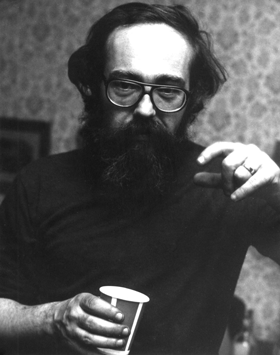 John Schoenherr at Boskone 9 in 1972 |
 Written by Kirk Snavely |
While dissecting a frog during biology class, at the science-oriented Stuyvesant High School, John Schoenherr decided to pursue a career in art. He liked drawing the frog better than taking it apart. His decision led to an impressive career in illustration and wildlife art.
He was born in New York City in 1935. At the age of four he began drawing to communicate with his friends, few of whom spoke English in the polyglot neighborhood of Queens where he lived. Through explorations of neighborhood fields and summer trips to the Adirondacks he developed a consuming interest in the natural world and became fascinated with stone. He explored caves and learned to rock climb.
After high school, Schoenherr attended the Pratt Institute in Brooklyn where he studied under Richard Bové and Stanley Meltzoff. During the summers he returned to the Art Students League to study with Frank Reilly. He enjoyed painting wildlife for assignments at Pratt, but was initially "assured that my good drawing eliminated that possibility" as a career (quoted in Marcia Preston, Beyond the Edge: John Schoenherr). It was a joke at the time that an ability to draw overqualified one to be a fine artist. After graduating from Pratt, he supported himself and his future family as a free-lance illustrator while cultivating his wildlife painting on the side.
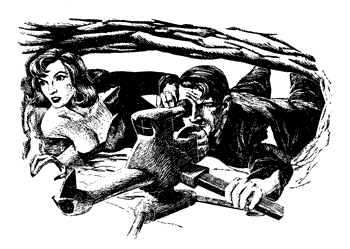 Schoenherr
began work in the field of science fiction illustration, in the
magazines he'd been reading since high school. At right is his
first published work, for Robert Moore Williams's The Next
Time We Die in the February 1957 issue of Amazing
Stories. One can already see the rounded shapes
he preferred to give to machinery, in this case the gun.
Schoenherr
began work in the field of science fiction illustration, in the
magazines he'd been reading since high school. At right is his
first published work, for Robert Moore Williams's The Next
Time We Die in the February 1957 issue of Amazing
Stories. One can already see the rounded shapes
he preferred to give to machinery, in this case the gun.
 In 1958 he began a long-term association with
Astounding Science Fiction, which changed
its name to Analog in 1960. The next
decade saw a steady stream of Schoenherr covers and interior illustrations
for the magazine. He was proud of the aliens he designed for Analog,
beings whose morphology fit their ecology. For the animal from
a heavy planet on the cover at left, from the August 1961 issue
of Analog, the structural support required
an extra pair of legs (relative to terrestrial mammals).
In 1958 he began a long-term association with
Astounding Science Fiction, which changed
its name to Analog in 1960. The next
decade saw a steady stream of Schoenherr covers and interior illustrations
for the magazine. He was proud of the aliens he designed for Analog,
beings whose morphology fit their ecology. For the animal from
a heavy planet on the cover at left, from the August 1961 issue
of Analog, the structural support required
an extra pair of legs (relative to terrestrial mammals).
 In 1961 Schoenherr started painting paperback
covers for science fiction, horror, and fantasy, primarily for
Pyramid and Ace. He painted many covers over the next decade.
At right is one of a series he did for Pyramid, and conveys his
interesting use of shapes and facial expressions that draw the
attention of the reader.
In 1961 Schoenherr started painting paperback
covers for science fiction, horror, and fantasy, primarily for
Pyramid and Ace. He painted many covers over the next decade.
At right is one of a series he did for Pyramid, and conveys his
interesting use of shapes and facial expressions that draw the
attention of the reader.
While doing some free-lance work for the Bronx zoo, he picked
up his first assignment to illustrate a children's book. His scratchboard
illustrations for Sterling North's Rascal (1963)
soon attracted the attention of other hardcover publishers. The
image below left is from the first Miska Miles book he worked
on, Mississippi Possum (1965), and displays Schoenherr's
humorous side. Some strategically placed berries entice the little
possum to stop playing dead. Note the question mark of his tail.
Another well-known title he illustrated was Walt Morey's Gentle
Ben (1965).
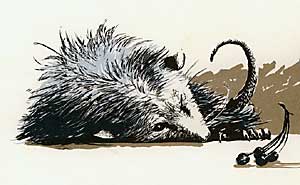 Schoenherr received the Hugo Award for Best
Artist at the World Science Fiction Convention in 1965. In the
previous year he provided magazine illustrations for Frank Herbert's
Dune, which first saw print as two Analog
serials between 1963 and 1965. He later produced all-new illustrations
for The Illustrated Dune (1978). In the handful
of scenes common to the magazine serial and the later book, one
can see the change in medium and style. The two illustrations
below depict the first appearance of a Fremen. The one on the
left, from Dune World in the January 1964 issue of Analog,
is rendered in scratchboard, Schoenherr's medium of choice early
on. The one on the right, from The Illustrated Dune,
is rendered in drybrush on watercolor paper, the medium he later
favored. The scratchboard is like a wood engraving in its precision,
whereas the drybrush is more diffuse and flowing. Both drawing
techniques display his superb draftsmanship.
Schoenherr received the Hugo Award for Best
Artist at the World Science Fiction Convention in 1965. In the
previous year he provided magazine illustrations for Frank Herbert's
Dune, which first saw print as two Analog
serials between 1963 and 1965. He later produced all-new illustrations
for The Illustrated Dune (1978). In the handful
of scenes common to the magazine serial and the later book, one
can see the change in medium and style. The two illustrations
below depict the first appearance of a Fremen. The one on the
left, from Dune World in the January 1964 issue of Analog,
is rendered in scratchboard, Schoenherr's medium of choice early
on. The one on the right, from The Illustrated Dune,
is rendered in drybrush on watercolor paper, the medium he later
favored. The scratchboard is like a wood engraving in its precision,
whereas the drybrush is more diffuse and flowing. Both drawing
techniques display his superb draftsmanship.
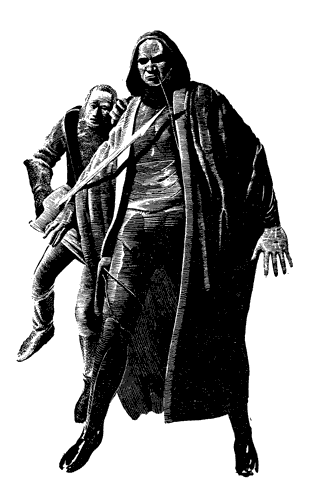
|
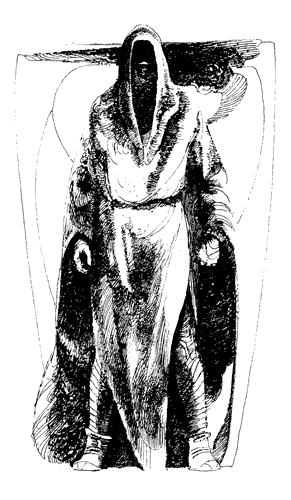
|
| 1964 | 1978 |
In the late sixties he took time off from Analog as he continued to develop his fine art technique. He liked to traverse the continent to study animals in the field, sometimes on commission, from eastern Canada to California and from the Everglades to Alaska. Once he spent a month in Iran. In the field he used a camera as his sketchbook, photographing the animals he would later paint in his studio, which was located on the rural farm in New Jersey where he lived with his family. Below right is one of his early paintings.
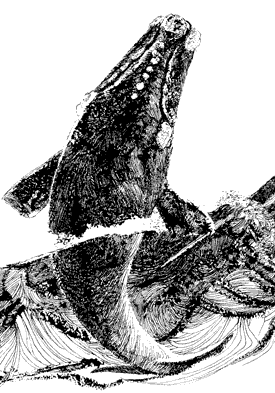
 Snowy Owl, oil, 1969 |
During this time he continued to illustrate wildlife books for children and young adults. In 1972 he worked on Jean Craighead George's Julie of the Wolves, which won the Newbery Medal. The southern right whale breaching at left is from the nonfiction book by Faith McNulty, Whales: Their Life in the Sea (1975). I get a feeling of joy from this picture, which displays the wonderful texture Schoenherr achieved with drybrush on watercolor paper.
Schoenherr returned to Analog for several years in the seventies. Then for the most part he left illustration behind, both science fiction and children's literature. He devoted himself to his wildlife painting in the late seventies, creating large works for galleries. His fine art has won awards and can be found in private collections as well as museums and galleries around the country.

Ursa Major, oil, 1981
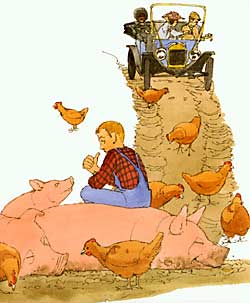 Schoenherr identifies with bears and has painted
them frequently, having a preference for painting large mammals
in general. In his work he strives to capture the essence of the
animal, using few brush strokes to create the illusion of detail,
and desires to make pictures that will stay in the memory of the
viewer. As quoted in the article by Frances Traher (John Schoenherr),
he says "By putting a lot of myself into a painting, something
inside the frame comes to exist by itself - almost like another
person."
Schoenherr identifies with bears and has painted
them frequently, having a preference for painting large mammals
in general. In his work he strives to capture the essence of the
animal, using few brush strokes to create the illusion of detail,
and desires to make pictures that will stay in the memory of the
viewer. As quoted in the article by Frances Traher (John Schoenherr),
he says "By putting a lot of myself into a painting, something
inside the frame comes to exist by itself - almost like another
person."
In 1987 he returned to children's literature and won the Caldecott Medal for his work on Jane Yolen's Owl Moon. He followed up with two of his own books, Bear (1991) and Rebel (1995). The watercolor at right is from the delightful Pigs in the Mud in the Middle of the Rud (1997), by Lynn Plourde.
John Schoenherr died in 2010.
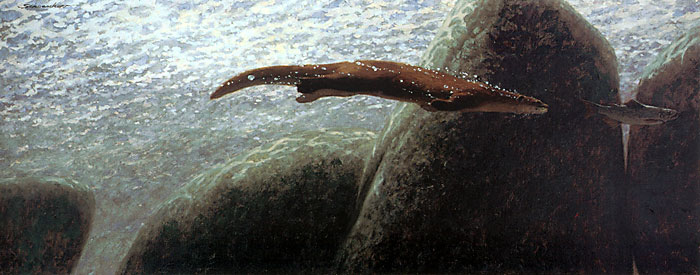
Hot Pursuit, oil, 1998
Acknowledgements
The artist has generously given his permission for the use of his work on this page. In addition, the two illustrations from Analog have copyrights to Conde Nast Publications, Inc. in their respective years of publication, and are used with permission of Dell Magazines, current publisher of Analog Science Fiction and Fact.
References
The Art of Painting Wild Animals, M. Grumbacher, Inc., New York, 1975
Barbara Cotton, John Schoenherr, Sports Afield, Vol. 193, No. 4, April 1985, pp. 82-87, 139
Vincent Di Fate, Infinite Worlds: The Fantastic Visions of Science Fiction Art, The Wonderland Press, Penguin Studio, New York, 1997
Vincent Di Fate, The Science Fiction Art of Vincent Di Fate, Paper Tiger, London, 2002
Vincent Di Fate, Sketches: John Schoenherr Interview, ALGOL: The Magazine About Science Fiction, Vol. 15, No. 3, Whole No. 32, Summer-Fall 1978, pp. 41-49
Patricia Lee Gauch, John Schoenherr, The Horn Book Magazine, Vol. 64, No. 4, July/August 1988, pp. 460-463
Donald J. Hagerty, Leading the West: One Hundred Contemporary Painters and Sculptors, Northland Publishing, Flagstaff, Arizona, 1997
Christopher Hume, From the Wild: Portfolios of North America's Finest Wildlife Artists, NorthWord, Inc., Ashland, Wisconsin, 1987
Illustrators of Children's Books: 1957-1966, compiled by Lee Kingman, Joanna Foster and Ruth Giles Lontoft, The Horn Book, Inc., Boston, 1968
John Schoenherr: Beyond the Edge and Deep Within, A Retrospective, 19 January to 13 April 1997, Hiram Blauvelt Art Museum, 1997
Kenneth Kirkeby, Bold & Beyond, Sporting Classics, Vol. 17, No. 5, September/October 1998, pp. 72-77
Sandra Miesel, A Look at John Schoenherr, Galileo/Magazine of Science and Fiction, March 1978, pp. 26-29
The New Encyclopedia of Science Fiction, James Gunn ed., Promised Land Productions, Inc., New York, 1988
Marcia Preston, Beyond the Edge: John Schoenherr, Wildlife Art, Vol. 15, No. 3, May/June 1996, pp. 24-29
John Schoenherr, Caldecott Medal Acceptance, The Horn Book Magazine, Vol. 64, No. 4, July/August 1988, pp. 457-459
Something About the Author: Facts and Pictures about Authors and Illustrators of Books for Young People, Anne Commire ed., Vol. 37, Gale Research Company, Detroit, Michigan, 1985
Frances Traher, John Schoenherr, Artists of the Rockies and the Golden West, Vol. 10, No. 3, Summer 1983, pp. 98-105
Robert Weinberg, A Biographical Dictionary of Science Fiction and Fantasy Artists, Greenwood Press, New York, 1988
Jacqueline Shachter Weiss, Profiles in Children's Literature: Discussions with Authors, Artists, and Editors, The Scarecrow Press, Inc., Lanham, Maryland, 2001
Wildlife Art 2000, Spanierman Gallery, LLC, New York, 2000
Click here for an expanded version of this Schoenherr biography.| Illustrations copyright by their respective owners. This page written, designed & © 2005 by Kirk Snavely. Updated 2010, 2011. |
